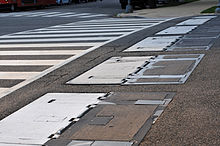Barrier (road traffic)
A barrier is used to demarcate an area of a traffic area in which road users are not allowed to stay or only to a limited extent. A distinction must be made between temporary and permanent barriers. The reason for a temporary cordoning off can be danger areas such as workplaces , events or an accident site. The barrier is ordered according to traffic law and set up by the police, for example. In order to keep the traffic obstruction as low as possible, diversions can be set up.
Permanent barriers are installed where traffic areas are permanently prohibited or where traffic routing is to be influenced. This is the case , for example, in traffic-calmed areas or pedestrian zones. The shut-off devices can, however, be dismantled quickly if, for example, access is to be made possible for emergency or rescue workers.
In Germany, pedestrians must not cross barriers, such as bar or chain railings. Barriers ( sign 600 ) prohibit entering the cordoned off street area. ( § 25 Abs. 4 StVO )
![]()
Shut-off devices
Shutting off different are as required shut-off devices (also stop devices called) to use:
- Barrier fences
- Barriers
- Barrier chains
- Warning signs
- Barriers
- Diagonal lock
The color scheme is eye-catching and is intended to draw the road users' attention at an early stage. Warning lights and beacons also improve visibility.
In order to be able to use the shut-off devices at a work site, they must be set up using the erection devices provided . These support devices include footplates , impact posts , and ground anchors. The signage is attached, for example, with the help of pipe clamps. Shut-off devices for workplaces must meet the specifications defined in the technical delivery conditions so that they can be used at workplaces.
Barriers also count as barriers. They are attached to customs borders , national borders , level crossings , non-public private roads and other traffic routes as a fixed traffic control device. A special case of cordoning off is the short-term erection of a road block by the police or other law enforcement or emergency services to prevent urgently suspected persons from continuing their journey. When moving from public land to private land, there are so-called lifting body locks in risk areas, which are sunk into the ground if necessary.
Development history
Until the end of the 1990s, mainly wooden or metal barriers were in use in Germany . Both variants were easy to transport and offered a sufficient level of security. However, there was always the risk of improper installation. For example, barriers with arrows pointing against the prescribed direction of travel were set up, as were warning beacons with incorrect alignment.
Since the end of the 1990s, barriers have been increasingly introduced. They no longer had directional arrows (like newer barriers). In addition, they also offered larger reflective surfaces , which resulted in better visibility in the dark. By extending the barriers with another metal strip just above the ground, the barriers were now also suitable for the blind. Up to now, blind road users have occasionally come under the barriers with their blind sticks and then ran into the barriers or into the insufficiently cordoned off room. This type of barrier-free barriers has long been mandatory in many countries (for example in the UK and the USA ). A wire connection between the two metal strips also made it difficult for children and animals to pass through the barrier.
In 2004, the barriers were revised again and now consist of plastic hollow bodies. The color of the plastic is specified in the technical delivery conditions. Contrary to these specifications, the color is often freely chosen by the barrier or construction company in practice. The aim is to enable the differentiation of shut-off systems from other companies by means of an individual form. There is currently a need for discussion in the specialist committees about admissibility.
Inadmissible shut-off devices
According to the guidelines, only shut-off devices that are approved as such are to be used. Therefore, outdated, modified or self-made systems may not be used. This is done for reasons of road safety and uniformity. The so-called Neptune hook , which is considered obsolete and no longer approved, should serve as an example at this point .





